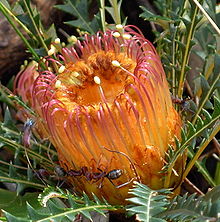- Dryandra ser. Niveae
-
Banksia dallanneyi (Couch Honeypot)

Dryandra ser. Niveae is an obsolete series within the former genus Dryandra (now Banksia ser. Dryandra). It was first published by George Bentham in 1870, and was given a new circumscription by Alex George in 1996, but was ultimately discarded in 2007 when Austin Mast and Kevin Thiele sunk Dryandra into Banksia.
Contents
According to Bentham
Bentham's definition of D. ser. Niveae was "Flowering stems from a creeping trunk very short, with one or few ovoid flower-heads surrounded by long floral leaves. Leaves pinnate with numerous rigid segments white underneath except in D. nana." Four species were included; the placement and circumscription of the series may be summarised as follows:[1]
- Dryandra (now Banksia ser. Dryandra)
- D. sect. Eudryandra
- D. ser. Armatæ (7 species)
- D. ser. Floribundæ (5 species, 2 varieties)
- B. nivea)
- D. arctotidis (now B. arctotidis)
- D. arctotidis var. tortifolia (now B. tortifolia)
- D. nana (now B. nana)
- D. Preissii (now B. acuminata)
- edit] According to George
With the passage of time following the publication of Bentham's arrangement, D. ser. Niveae was gradually abandoned. As the flowers and fruit are highly similar across all species in the series, it is difficult to distinguish individual species. For this reason the name Dryandra nivea began to be used in a broad sense, to refer to the entire group, and the other species names fell into disuse.
When Alex George published his revision of Dryandra in 1996, he recognised that there were several taxa in the series, and that these could be distinguished by their leaf shape. He resurrected a number of abandoned names, and published some new species and varieties. A new circumscription was given for the series: essentially the series was defined as containing those species in which the flowers of a flower head form a circle about a central hole.[2]
George's placement and circumscription of D. ser. Niveae, as amended in 1999[3] and 2005,[4] may be summarised as follows:
- Dryandra (now Banksia ser. Dryandra)
- D. subg. Dryandra
- D. ser. Floribundae (1 species, 4 varieties)
- D. ser. Armatae (21 species, 7 subspecies, 4 varieties)
- B. arctotidis)
- D. tortifolia (now B. tortifolia)
- D. stenoprion (now B. stenoprion)
- D. cypholoba (now B. cypholoba)
- D. lindleyana (now B. dallanneyi)
- D. lindleyana subsp. lindleyana (now B. dallanneyi subsp. dallanneyi)
- D. lindleyana subsp. pollosta (now B. dallanneyi subsp. pollosta)
- D. lindleyana subsp. media (now B. dallanneyi subsp. media)
- D. lindleyana subsp. agricola (now B. dallanneyi subsp. agricola)
- D. lindleyana subsp. sylvestris (now B. dallanneyi subsp. sylvestris)
- D. brownii (now B. brunnea)
- D. nivea (now B. nivea)
- D. nivea subsp. nivea (now edit] Recent developments
Since 1998, Austin Mast has been publishing results of ongoing cladistic analyses of DNA sequence data for the subtribe Banksiinae. His analyses have provided compelling evidence of the paraphyly of Banksia with respect to Dryandra; that is, it seems that Dryandra arose from within the ranks of Banksia.[5][6][7] Early in 2007, Mast and Kevin Thiele initiated a rearrangement of Banksia by sinking Dryandra into it as B. ser. Dryandra. This transfer necessitated the setting aside of George's infrageneric arrangement of Dryandra; thus D. ser. Niveae is no longer current. Mast and Thiele have foreshadowed publishing a full arrangement once DNA sampling of Dryandra is complete.[8]
References
- ^ Bentham, George (1870). "Dryandra". Flora Australiensis. 5. London: L. Reeve & Co.. pp. 562–584.
- ^ George, Alex (1996). "New taxa and a new infrageneric classification in Dryandra R.Br. (Proteaceae: Grevilleoideae)". Nuytsia 10 (3): 313–408.
- ^ George, Alex S. (1999). "Dryandra". In Wilson, Annette (ed.). Flora of Australia. 17B. Collingwood, Victoria: CSIRO Publishing / Australian Biological Resources Study. ISBN 0-643-06454-0.
- ^ George, A. S. (2005). "Further new taxa in Dryandra R.Br. (Proteaceae: Grevilleoideae)". Nuytsia 15 (3): 337–346. http://www.naturebase.net/images/stories/nature/science/nuytsia/15/3/337-346.pdf.
- ^ Mast, Austin R. (1998). "Molecular systematics of subtribe Banksiinae (Banksia and Dryandra; Proteaceae) based on cpDNA and nrDNA sequence data: implications for taxonomy and biogeography". Australian Systematic Botany 11 (4): 321–342. doi:10.1071/SB97026.
- ^ Mast, Austin R. and Thomas J. Givnish (2002). "Historical biogeography and the origin of stomatal distributions in Banksia and Dryandra (Proteaceae) based on Their cpDNA phylogeny". American Journal of Botany 89 (8): 1311–1323. doi:10.3732/ajb.89.8.1311. ISSN 0002-9122. PMID 21665734. http://www.amjbot.org/cgi/content/full/89/8/1311. Retrieved 2006-07-02.
- ^ Mast, Austin R., Eric H. Jones and Shawn P. Havery (2005). "An assessment of old and new DNA sequence evidence for the paraphyly of Banksia with respect to Dryandra (Proteaceae)". Australian Systematic Botany (CSIRO Publishing / Australian Systematic Botany Society) 18 (1): 75–88. doi:10.1071/SB04015.
- ^ Mast, Austin R. and Kevin Thiele (2007). "The transfer of Dryandra R.Br. to Banksia L.f. (Proteaceae)". Australian Systematic Botany 20: 63–71. doi:10.1071/SB06016.
External links
- "Dryandra ser. Niveae Benth.". Flora of Australia Online. Department of the Environment and Heritage, Australian Government. http://www.anbg.gov.au/abrs/online-resources/flora/stddisplay.xsql?pnid=46563.
- D. nivea subsp. nivea (now edit] Recent developments
- D. subg. Dryandra
- Dryandra (now Banksia ser. Dryandra)
- D. sect. Eudryandra
Categories:- Banksia taxa by scientific name
- Banksia ser. Dryandra
- Obsolete taxonomic groups
- Plant series
- Dryandra (now Banksia ser. Dryandra)
Wikimedia Foundation. 2010.

